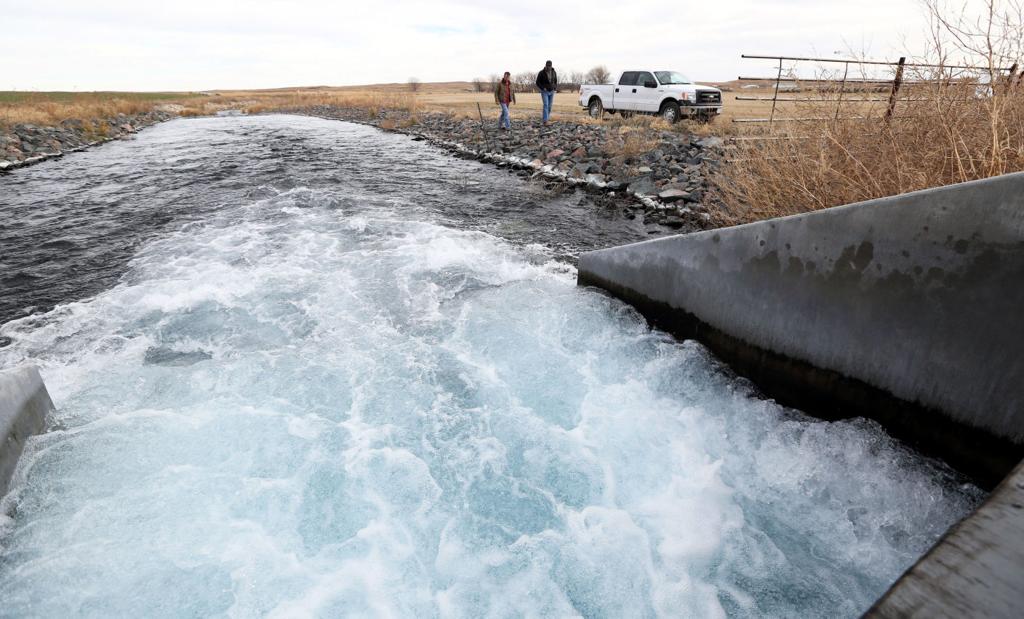DICKENS, Neb. — For the third consecutive year, Nebraska is tapping a vein of its water wealth in a groundbreaking venture to avoid another legal battle with Kansas over the Republican River.
Millions of gallons of water pumped by a battery of wells from deep underground and piped across the southwest Nebraska plains are cascading into Medicine Creek and coursing downstream to Cambridge and the Republican River, where the water eventually flows into Kansas.
The water has been flowing all winter. The current flush started in late October and isn’t expected to stop until this spring. That’s when enough water to cover 31,000 acres — more than 48 square miles — a foot deep will have been pumped to augment flows in the Republican.
But this year, Nebraska is getting more bang for the buck — call it gusto per gallon — for the water.
That’s because a U.S. Supreme Court decision last February and a new agreement involving Nebraska, Kansas and Colorado — the three states that share the river under a 1942 compact — will significantly decrease the volume of water pumped, said Nate Jenkins, assistant manager of the Upper Republican Natural Resources District in Imperial.
New operating guidelines now in play are expected to reduce the amount of water the project generates by about 60 percent.
“If this was 2014, we’d be pumping almost twice as much water as we’re going to in 2016,’’ Jenkins said.
The Upper Republican NRD and three other districts in the region launched the augmentation initiative a bit more than three years ago and named it the Nebraska Cooperative Republican Platte Enhancement project. It’s commonly known in the western Nebraska water world by its acronym, NCORPE.
The project goal: Ensure that Nebraska’s river flow obligations in the Republican and Platte Rivers are met by increasing stream flows with water that otherwise would have been used to irrigate corn and other crops on a sliver of the Sand Hills near North Platte.
The alternative: Renewed legal skirmishes with Kansas and, possibly, a court-ordered shutdown of hundreds of thousands of the state’s irrigated acres in the Republican River basin.
The Republican is a fragile river that rises in the high plains of eastern Colorado. It is fed by prairie streams and seepage from underground water, not melting snow from the Rocky Mountains.
The river wends its way eastward into southwest and southern Nebraska, where is passes through Swanson and Harlan County Reservoirs. It veers south into Kansas near Superior, Nebraska.
During dry years and drought, Nebraska has struggled to ensure that Kansas receives its legal share of river water, especially after decades of deep-well irrigation development lowered water tables and depleted river flows. Kansas has twice since 1998 taken Nebraska to the Supreme Court over the issue.
Over the years Nebraska tried to remain in compliance. Water managers imposed restrictions on irrigators in the basin, developed conservation plans and prayed for rain. The strategy worked during wet times and not so well during dry spells. The idea of pumping underground water to augment Republican flows percolated in the background.
The year 2011 was very wet across the region. Rain and melting snow had been providing adequate flows in the Republican. The region’s reservoirs were full. Kansas got its water. Nebraska’s three Republican River natural resources districts didn’t have to do anything extraordinary to maintain compliance with the interstate compact that governs the stream.
Then the severe drought of 2012 hit.
“The bottom just fell out,’’ Jenkins said.
Some reservoirs in the Republican system dropped as much as 20 feet under the stress of no rainfall and heavy irrigation demand.
By September 2012, NRD managers knew they needed to find water somewhere, quickly. A little augmentation project on Rock Creek in Dundy County in the far southwest corner of the state was quickly doubled in size to help generate the volume of water that would be needed to pump into the Republican.
Still, the southwest Nebraska water managers didn’t have a project in place to cover the projected shortfall.
Jenkins said the augmentation project was inspired by Nebraska Department of Natural Resources officials who suggested a bold scheme: a sprawling irrigated farm southwest of North Platte was on the market. It had 115 groundwater wells, but the sandy soil was marginal cropland for nourishing corn, potatoes, soybeans and popcorn — and it was susceptible to wind erosion. The 19,500-acre Lincoln County property straddled the Platte and Republican River basins. Why not buy the farm, retire and restore the cropland to grassland and tap the aquifer for augmenting flows in the rivers?
Similar to the Republican and its compact obligations, the Twin Platte NRD in North Platte is under state and federal deadlines to increase flows in the Platte to 1997 conditions, in part to benefit threatened and endangered species.
The two-river augmentation strategy was simple. By ceasing irrigation across thousands of acres on the sprawling Lincoln County farm, water that would have continued to be used for cropland would remain in the Ogallala Aquifer until needed to supplement flows in the Republican and Platte.
The Upper, Middle, Lower Republican and Twin Platte NRDs dove into the project. The roughly $110 million project is solely funded by an occupation tax on irrigated acres. No property taxes are used. The Nebraska Cooperative Republican Platte Enhancement project was running by early 2014.
Thirty high-capacity wells were linked with more than 20 miles of pipeline. A 42-inch main transmission line transported water across seven miles of prairie to the headwaters of Medicine Creek near Dickens.
Construction of a pipeline north to the Platte River is slated for this summer.
Jenkins said the NRDs had contingency plans to keep Nebraska in Republican River compact compliance without the pipeline, but they weren’t pretty.
“We went from thinking it would be total chaos and, quite frankly, lawsuit after lawsuit to putting in place a $110 million project pretty quickly,’’ he said.
The project prevented the shutdown of about 330,000 irrigated acres in southwest and south-central Nebraska that first year. That’s the equivalent of about a third of the basin’s irrigated cropland. And Nebraska would have shut down the same number last year and again this year.
Such irrigation shutdowns could cause assessed values of irrigated land within the basin to decline by an estimated $500 million to $900 million. In the Twin Platte NRD, the reduction in assessed values could be about $70 million.
Kyle Shepherd of North Platte, the project manager, said augmentation pumping is a valuable tool.
“The NRDs have projects to increase stream flow, but this is reliable and immediate,’’ he said. “You can turn it on in a drought. It’s here. It’s invaluable.’’
Had the Supreme Court granted Kansas’ demands in its latest lawsuit, about 500,000 acres of irrigated farmland in Nebraska would have been shut down, the state fined $70 million and a federal water master put in control of the river in the state.
“We don’t want any of that,’’ Shepherd said.

Water pumped from 30 irrigation wells south of North Platte pours into the headwaters of Medicine Creek, a Republican River tributary. The water enhances flows during drought conditions to help keep Nebraska in compliance with an interstate compact governing use of the Republican River by Nebraska, Colorado and Kansas.

Kyle Shepherd




